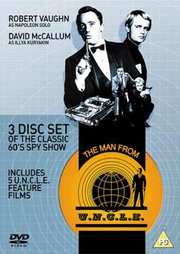Review of Man From UNCLE, The (Box Set)
Introduction
Open Channel D...
All aspiring UNCLE agents in the 1960s had to do was whip out a biro, give the top a twist and say "open channel D" and they were in contact with UNCLE headquarters and the venerable Mr Waverley. Operating out of a secret base fronted by Del Floria`s cleaners in the shadow of the UN building in Manhattan, UNCLE had nothing to do with that organisation (in fact it`s a New York statute that it`s a criminal offence to pass yourself off as part of the UN when you`re not). UNCLE stood for the United Network Command for Law and Enforcement and its beat was the same world of megalomaniacs, secret formulae and kidnapped scientists` daughters as the big screen secret agents.
"The Man From UNCLE" was created for television by Sam Rolfe. Series producer Norman Felton had been introduced to the ailing Ian Fleming, creator of James Bond with a view to developing a tv version of another of Fleming`s books. Fleming offered a few sketchy ideas he had jotted down on a wad of telegram blanks which, with further input from various executives and interested parties became the outline for a show to be called Solo.
At that point Harry Saltzman and Cubby Broccoli stepped in, objecting to the use of the name when there was a character in their upcoming release of Goldfinger called Solo. (You remember, the feller who had the "pressing engagement"). Although there was no relationship between Napoleon Solo and the squished hood in Goldfinger, the network`s legal department advised a change of title and The Man From UNCLE was born.
While the original intent was for the show to be about suave, sophisticated Napoleon Solo (played by the suave, sophisticated Robert Vaughn), his co-stars David McCallum (playing Russian UNCLE agent Illya Kuryakin) and Leo G. Carroll (as Mr Waverley) soon turned the show into a three-hand effort that rivalled the exploits of Kirk, Spock and Bones McCoy for cool. At the height of the show`s powers, David McCallum was one of the top teenybopper icons of the 1960s.
During the early run of the show, it was decided to introduce foreign markets to the series by releasing enhanced versions of episodes as feature films. The series pilot and a second episode from the first season were enhanced with additional footage, tame by today`s standards but risque for television of that era. While the pilot story isn`t included in this pack, "The Spy With My Face" is, and the additional material (featuring Sharon Farrell) sticks out a mile. In later seasons, two-part episodes were developed with the intention of releasing them as feature films in foreign markets.
This five-movie set comes on three discs. The first disc features "The Spy With My Face" and "One Spy Too Many". The first story is the old evil twin deal and culminates in Robert Vaughn beating himself up. "One Spy Too Many" sets Solo and Kuryakin against industrialist megalomaniac Alexander (played by Men In Black boss-to-be Rip Torn. MiB, incidentally owes a lot to UNCLE for its style and structure). The second disc contains my personal favourite story, "The Karate Killers" where Solo and Kuryakin are trying to track down four daughters of a scientist who had developed a formula for extracting gold from seawater. The cast list for this one includes Joan Crawford, Telly Savalas, Curt Jurgens, Herbert Lom, Kim Darby, Jill Ireland and Terry-Thomas. "The Helicopter Spies" features Bradford Dillman out to hold the world to ransom with a thermal prism, and the experience temporarily gives Napoleon Solo white hair. The final disc in the set features the story "How To Steal The World", which was the last episode of the series ever made. Extensively using the newly-opened terminal building of Los Angeles International Airport as a backdrop, the adventure is all about world domination, "will gas" and has Naked Gun-ner Leslie Nielsen in a straight role as one of the villains. The third disc includes the extensive DVD-ROM "downloadable features", a set of eight Adobe Acrobat .pdf files that to be honest would have been better as a knock-out brochure included in the set, as they are beautifully laid out and illustrated.
Video
Sadly, little has been done to improve the lot of these movies and the source material suffers from some print dirt and wear and tear. Presented in the original tv format 1.33:1 - the movies would have been treated as open matte for theatrical showing and masked down to 1.85:1 - they exhibit that pleasantly colourful 1960s look. Details are clear, although there is a little digital artefacting caused by the higher compression rate required to put two movies on each disc. The set is nonetheless a pleasing reminder of a great sixties iconic television series.
Audio
The movies are presented in DD2.0 mono.
Features
Unfortunately, Warner Bros have done little with the set except for the DVD-ROM brochure mentioned above. There are no additional extras, and the Studio has committed the cardinal sin (in my eyes) of not including Hard of Hearing subtitles. The packaging - a three-fold digipak in a card box like the recent Hammer releases is pleasing to the eye.
Conclusion
I was pleased with the set, in spite of the few niggles about extras and quality mentioned above. Considering what is and isn`t available on our favourite format, I`m just glad to finally have digital quality copies of a group of movies I`d formerly had to record off TNT.

































Your Opinions and Comments
Be the first to post a comment!